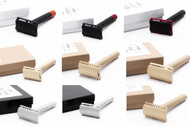Karve Plate Selection
9th Mar 2022
PLATE SELECTION
TYPES AND LEVELS OF PLATES
The Christopher Bradley use can be built up with two types of plates:
- open comb (OC) plates (left below)
- solid bar (SB) plates (right below)

In addition to the two different plate types, the Christopher Bradley razor employs 8 different levels of OC plates and 8 different levels of SB plates to adjust its aggressiveness.
The levels range from AA (the least aggressive) to G (the most aggressive).
Keep in mind that each level denotes a specific blade geometry, not shaving performance.
The geometry of each plate is as follows:
- AA - gap = 0.47mm / exposure = negative 0.07mm
- A - gap = 0.60mm / exposure = negative 0.02mm
- B - gap = 0.73mm / exposure = zero
- C - gap = 0.85mm / exposure = positive 0.09mm
- D - gap = 0.98mm / exposure = positive 0.13mm
- E - gap = 1.10mm / exposure = positive 0.17mm
- F - gap = 1.23mm / exposure = positive 0.22mm
- G - gap = 1.36mm / exposure = positive 0.25mm
Blade gap (the space under the cutting edge), blade exposure (how far the cutting edge is sticking out), blade angle (the angle of the cutting edge relative to the razor), and blade support (how well the cutting edge is supported) all contribute to aggressiveness and performance.
PICKING AN OPEN COMB OR A SOLID BAR PLATE
SB plates are less aggressive than OC plates because the SB plate's unbroken barrier provides more protection to the user's skin (this is the 'safety' in safety razor).
Two of the advantages of an OC plate are that they allow more lather to make it to the blade during shaving and they are better at lifting hair, which can result in a closer shave.
Also, for a given blade geometry configuration, an OC plate will be more aggressive and provide more feedback to the user than an SB plate.
So...it ultimately comes down to personal preference. An OC plate has a distinct feel and performs a little differently than an SB plate, which some wet shavers prefer.
Although they can be used for daily shaving, an OC plate also tends to be better at dealing with longer growth that comes from longer periods between shaves.
Due to the increased aggressiveness over an SB plate, an OC plate will require more attention to use, but this will come naturally to most experienced wet shavers. Beginners can manage an OC plate as well - it will just require a little more care.
SELECTING YOUR FIRST KARVE SAFETY RAZOR
To choose an SB plate, compare the blade gap of your current razor to the blade gap list for the SB plates here. If you don't have a measurement, you might be able to find it online or you'll need to determine it yourself (with a set of feeler gages).
To chose an OC plate, do the same blade gap comparison as you would for an SB plate and then continue below.
SELECTING AN OPEN COMB PLATE
Since the plate levels are based on the actual blade geometry, not shaving performance, a given level OC plate is not going to feel identical to as the same level SB plate.
Use the following rule of thumb to select an OC plate level:
If you want to maintain a similar level of aggressiveness, drop down one level when moving from SB to OC.
For example, an SB-C plate will be similar to an OC-B plate.
And, for you wet shavers that didn't think that the SB-F plate was aggressive enough, the OC-F plate is effectively an SB-G plate!
SELECTING YOUR FIRST SAFETY RAZOR EVER
Most people using a safety razor for the first time can start with the SB-B plate. If you have specific problems that you are trying to manage (such as sensitivity or razor burn), you can start with an SB-A or an SB-AA plate, depending on the severity of the issue.
Higher level plates are definitely OK for beginners - safety razors require control of contact pressure and cutting angle to function properly and the higher level plates are more sensitive to good form.
STILL NEED HELP?
These guidelines are not set in stone and everyone is a little different, so stepping up or down in the levels is perfectly acceptable. If you need help choosing a plate, please send a message.






